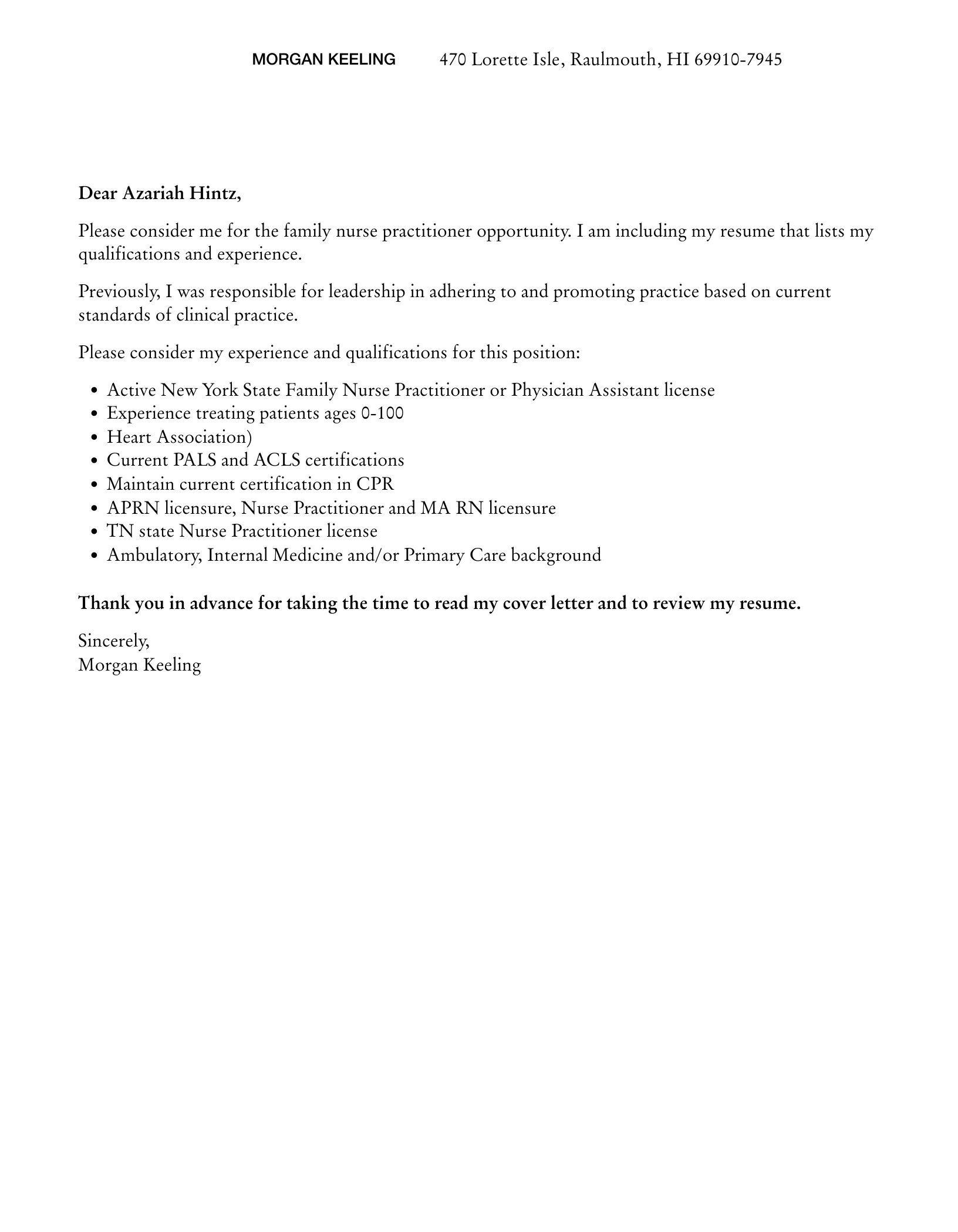Understanding the Importance of a Cover Letter
In the competitive field of healthcare, especially for Family Nurse Practitioners (FNPs), a well-crafted cover letter is often the first impression you make on a potential employer. It’s not just a formality; it’s a critical tool that can set you apart from other candidates. A cover letter allows you to provide context to your resume, showcasing your personality, passion, and how your skills align with the specific job requirements. It provides an opportunity to elaborate on your experiences, highlighting achievements and demonstrating your commitment to patient care. In essence, a strong cover letter is your personal marketing document, designed to convince the hiring manager that you’re the best fit for the role and worth an interview. Therefore, dedicating time and effort to create a compelling cover letter is an investment in your career.
Why a Cover Letter is Essential
A cover letter goes beyond the basic information provided in your resume. While your resume lists your qualifications and experiences, your cover letter tells your story. It allows you to explain your career goals, express your enthusiasm for the specific position, and demonstrate your understanding of the healthcare organization’s mission and values. A well-written cover letter can bridge any gaps or address any concerns the employer might have based on your resume alone. It allows you to highlight your soft skills, such as communication, empathy, and teamwork, which are crucial in a patient-centered environment. Furthermore, a cover letter gives you the chance to tailor your application to each job, showing that you have taken the time to understand the specific needs and expectations of the role and the healthcare facility. This personalized approach significantly increases your chances of being selected for an interview.
Highlighting Your Unique Value Proposition
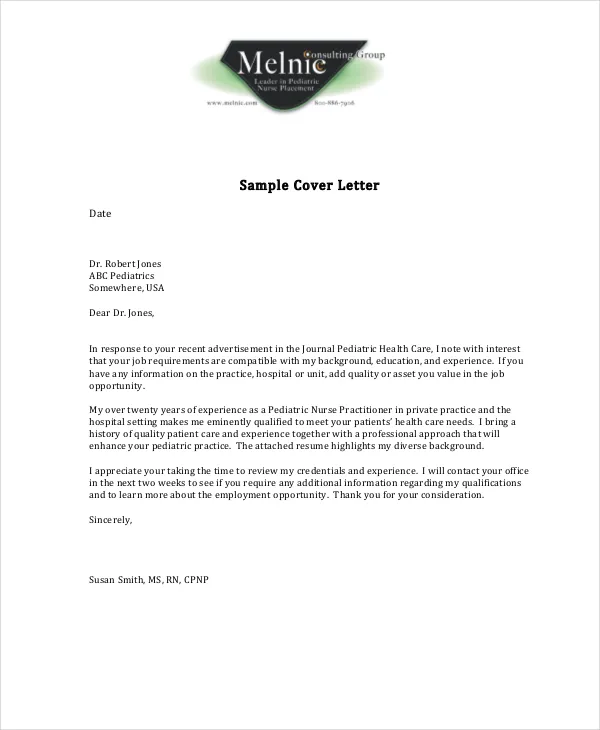
As a Family Nurse Practitioner, you bring a unique blend of clinical expertise, patient care skills, and a holistic approach to healthcare. Your cover letter should clearly articulate this value proposition. Start by identifying what makes you stand out from other candidates. Consider your specializations, certifications, and any specific experiences that align with the job requirements. Do you have experience in a particular area of family medicine, such as pediatrics, geriatrics, or chronic disease management? Have you contributed to any quality improvement initiatives or patient satisfaction projects? Showcase these accomplishments with quantifiable results whenever possible. For example, instead of saying you improved patient outcomes, state that you ‘reduced patient readmission rates by 15% through implementing a new discharge planning process.’ Your cover letter is your opportunity to demonstrate the value you can bring to the healthcare team and the patients you will serve.
Key Components of a Winning Family Nurse Practitioner Cover Letter
A successful cover letter includes several key elements that work together to create a persuasive and professional document. Begin with your contact information, followed by the date and the hiring manager’s information. The body of the letter should be well-structured, starting with a compelling opening paragraph that captures the reader’s attention. The middle paragraphs should highlight your relevant experience, skills, and achievements, using specific examples to support your claims. Tailor your letter to the specific job and organization by mentioning your research and expressing your enthusiasm for the role. Finish with a strong closing paragraph, expressing your interest in an interview and thanking the hiring manager for their time and consideration. Remember to proofread your letter meticulously for any errors in grammar or spelling, and ensure it has a professional and polished look.
Your Contact Information and Professional Greeting
Start your cover letter with your full name, address, phone number, and email address. Ensure your email address is professional and reflects your name rather than a nickname. Below your contact information, include the date, and then the hiring manager’s name and title, if known. If you cannot find the hiring manager’s name, use a general greeting such as “Dear Hiring Manager.” Avoid generic greetings like “To Whom It May Concern,” as this shows a lack of effort in your research. Always address the letter to a specific person if possible, as this demonstrates your attention to detail and personalization. This initial section sets the tone for the rest of your letter, signaling professionalism and organization.
Crafting a Compelling Opening Paragraph
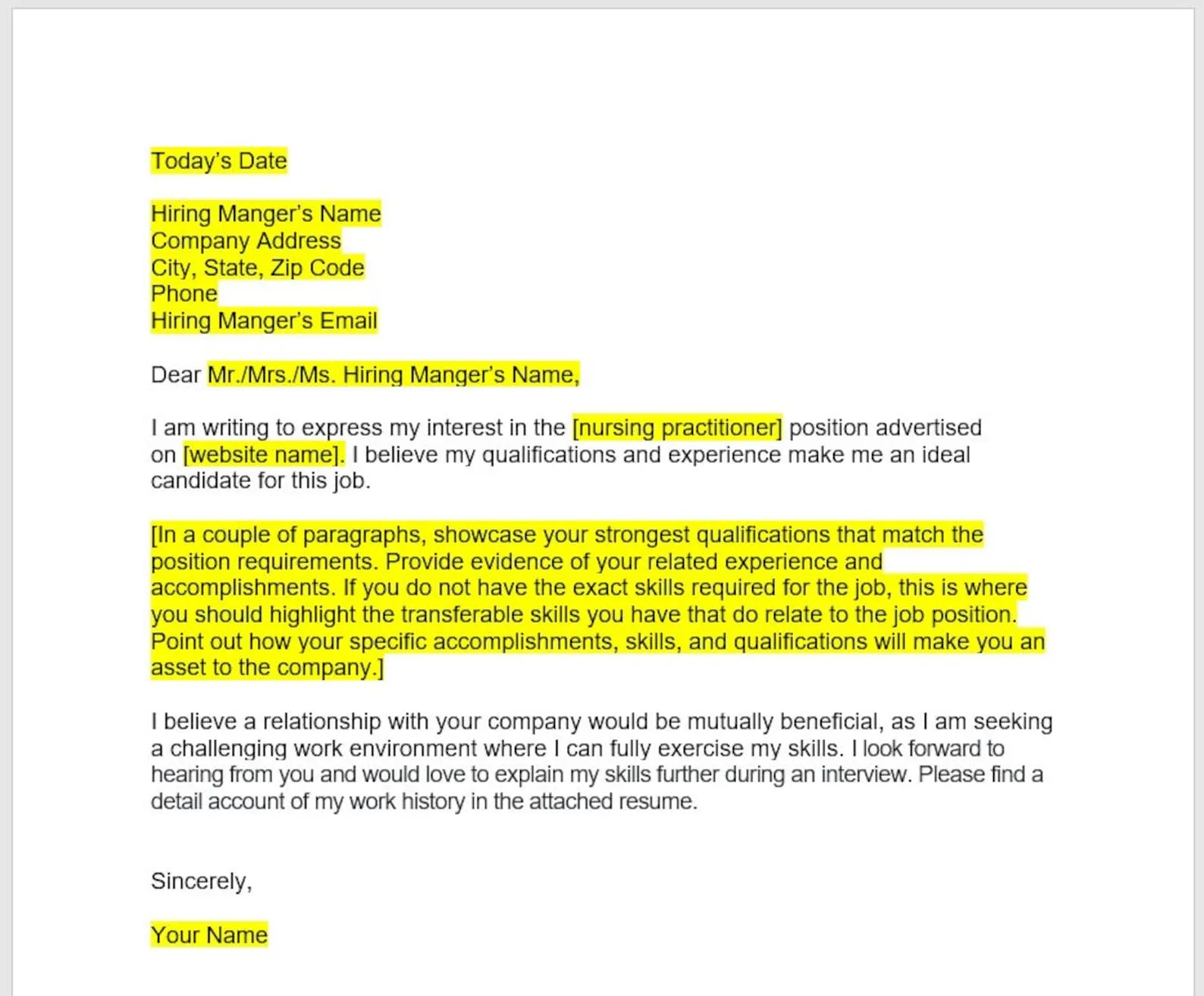
The opening paragraph of your cover letter is crucial; it’s your chance to grab the reader’s attention and make them want to read more. Start by clearly stating the position you’re applying for and where you saw the job posting. Then, briefly introduce yourself and highlight your most relevant qualification or experience. This could be a key skill, a significant achievement, or a specific area of expertise that aligns with the job requirements. Consider expressing your enthusiasm for the role and the organization. For example, you might start with, “I am writing to express my keen interest in the Family Nurse Practitioner position at [Hospital Name], as advertised on [Platform Name].” Briefly mention your background and quickly establish your value proposition, making it clear why you are a strong candidate right from the start. Keep it concise, and make sure it sets a positive tone for the rest of the letter.
Showcasing Your Experience and Skills
The body of your cover letter should focus on your relevant experience and skills. Instead of merely listing your past job duties, provide specific examples of your accomplishments and how you applied your skills to achieve positive outcomes. Refer to your resume, but expand on the details. Explain the context, the actions you took, and the results you achieved. For each experience, highlight skills that align with the job description, such as patient assessment, diagnosis, treatment planning, medication management, and patient education. Mention any specialized training or certifications that are relevant to the role. Use action verbs to describe your responsibilities, such as ‘assessed,’ ‘diagnosed,’ ‘managed,’ ’educated,’ and ‘collaborated.’ Demonstrate how you have effectively applied your skills to improve patient care, increase efficiency, or contribute to a positive work environment.
Quantifying Your Achievements
Whenever possible, quantify your achievements with specific numbers and data. This adds credibility to your claims and demonstrates your impact. For example, instead of saying “Improved patient satisfaction,” state “Improved patient satisfaction scores by 15% through implementing a new patient communication protocol.” Use metrics to highlight your efficiency, such as the number of patients seen per day, the reduction in waiting times, or the decrease in medication errors. If you have been involved in any research projects, mention the outcomes or publications. Provide concrete examples of how you have contributed to positive patient outcomes, cost savings, or process improvements. Quantifying your achievements allows the hiring manager to clearly see the value you can bring to the organization.
Demonstrating Your Passion for Patient Care
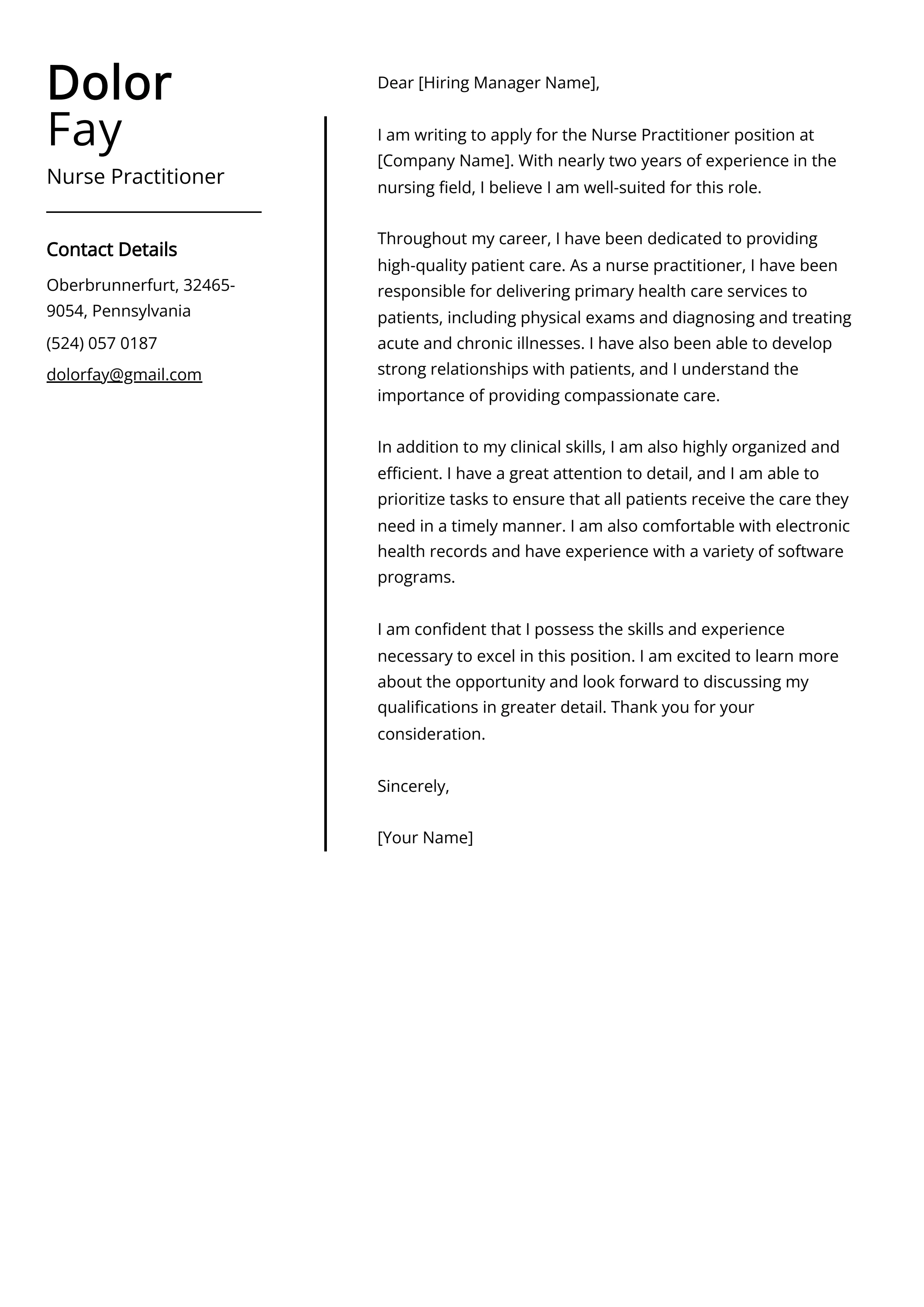
As a Family Nurse Practitioner, your passion for patient care is essential. Your cover letter should convey this passion by showing your commitment to providing compassionate, patient-centered care. Explain why you chose to become an FNP and what motivates you in your work. Discuss your approach to patient interactions, emphasizing your empathy, communication skills, and ability to build rapport with patients and their families. Mention any experience in patient education, counseling, or advocacy. Describe your philosophy of care and how you strive to improve patient outcomes. Highlight your understanding of the challenges faced by patients and your dedication to providing holistic care. Sharing your passion for patient care will make a positive impression and show that you are the right fit for the role.
Tailoring Your Letter to the Specific Job
Customize your cover letter for each job application. Read the job description carefully and identify the key skills, qualifications, and experiences the employer is seeking. Then, tailor your letter to directly address these requirements. Use keywords from the job description throughout your letter to demonstrate that you have the skills and experiences that match their needs. Highlight any relevant certifications, training, or experience, and give specific examples of how you have demonstrated those skills in the past. By tailoring your letter, you show that you are genuinely interested in the specific position and that you have taken the time to understand the employer’s needs. This personalization significantly increases your chances of getting an interview.
Researching the Employer and the Role
Before writing your cover letter, conduct thorough research on the employer and the role. Visit the healthcare organization’s website to learn about its mission, values, and services. Understand the types of patients they serve and the specific challenges they face. If possible, research the hiring manager or the team you would be working with. This information will help you personalize your letter and demonstrate your genuine interest in the role. Mention specific initiatives or programs of the organization that align with your interests and experience. Show that you have a deep understanding of the organization and how you can contribute to its success. By demonstrating your knowledge of the employer, you signal your commitment and your desire to be a valuable part of their team.
Using Keywords to Optimize Your Letter
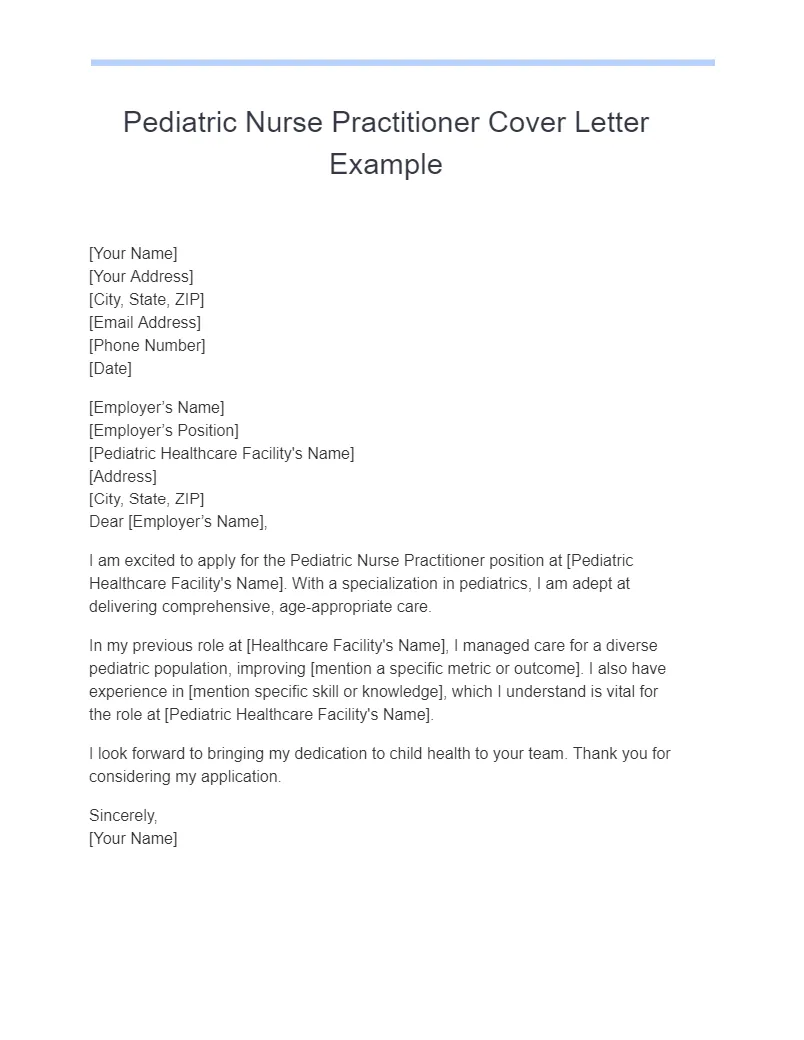
In today’s digital world, many employers use Applicant Tracking Systems (ATS) to screen resumes and cover letters. To increase your chances of getting past the initial screening, incorporate relevant keywords from the job description into your cover letter. Identify the key skills, qualifications, and experiences the employer is seeking, and use those words and phrases naturally throughout your letter. Don’t simply stuff your letter with keywords; instead, integrate them into your sentences and descriptions. This will help the ATS recognize your letter as a match for the job, ensuring it reaches the hiring manager. Focus on the important keywords and phrases to make sure your application stands out.
Writing a Strong Closing Paragraph
Your closing paragraph should summarize your interest in the position and express your enthusiasm for an interview. Reiterate your key qualifications and skills, briefly summarizing why you are a strong candidate. State your availability for an interview and how the hiring manager can contact you. Thank the hiring manager for their time and consideration. Maintain a professional and confident tone. For example, you might write, “Thank you for considering my application. I am eager to learn more about this opportunity and discuss how my skills and experience can benefit [Hospital Name]. I am available for an interview at your earliest convenience and can be reached at [phone number] or [email address].” Your closing should leave a lasting positive impression.
Expressing Your Enthusiasm and Call to Action
The closing paragraph is also your opportunity to express your enthusiasm for the role and make a clear call to action. Don’t just thank the hiring manager and end the letter; actively express your interest in an interview and provide your contact information again. Use phrases such as “I am excited about the opportunity to contribute to your team” or “I am eager to discuss how my skills align with your needs.” Encourage the hiring manager to take the next step by inviting them to contact you. Make it easy for them to schedule an interview. By ending with a clear call to action, you increase your chances of receiving a response and moving forward in the hiring process.
Proofreading and Editing Your Cover Letter
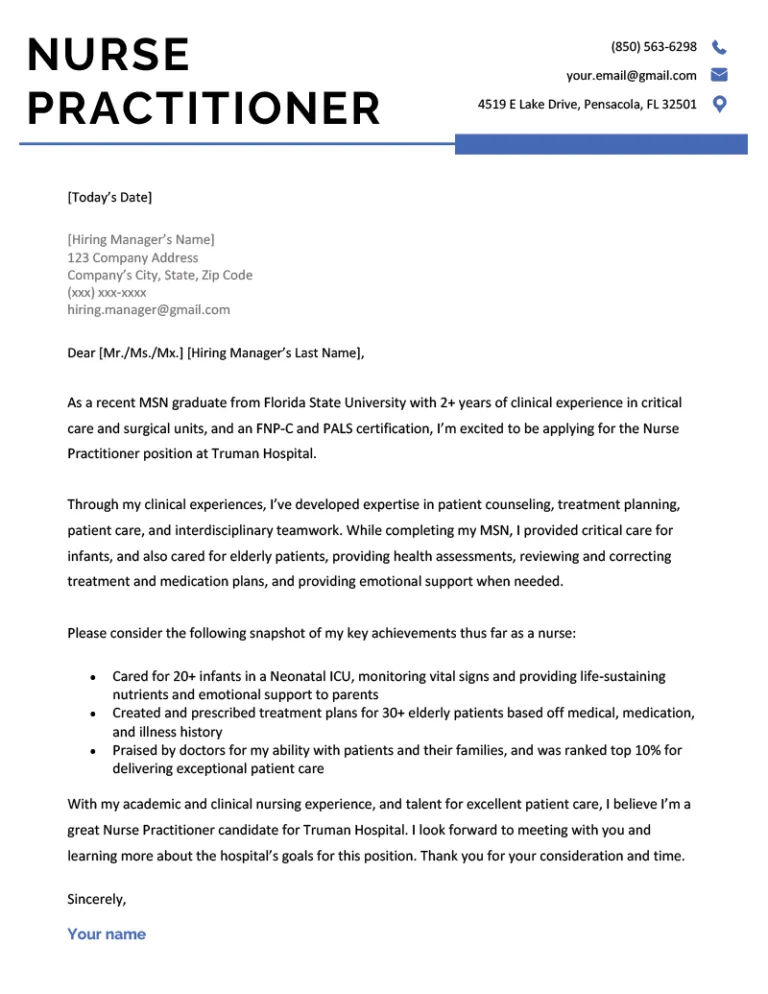
Before submitting your cover letter, proofread it carefully. Typos, grammatical errors, and formatting issues can make a negative impression and undermine your credibility. Read the letter aloud to catch any awkward phrasing or unclear sentences. Check for spelling errors using a spell-checker, but also read the letter carefully, as spell-checkers don’t always catch everything. Ensure the font is readable, the margins are consistent, and the overall appearance is professional. Consider having a friend or colleague review your letter for clarity, accuracy, and overall effectiveness. A well-proofread cover letter demonstrates your attention to detail and professionalism, showing that you care about the quality of your application.
Checking for Grammar and Spelling Errors
Thoroughly check your cover letter for grammatical and spelling errors. Run your letter through a grammar and spell-checking tool, but don’t rely on these tools alone. Read the letter carefully yourself, looking for mistakes that automated tools might miss. Pay attention to sentence structure, subject-verb agreement, and the correct use of punctuation. Ensure your word choice is appropriate for a professional setting. Poor grammar and spelling errors can make you appear unprofessional and can negatively impact your chances of getting an interview. Take the time to ensure your cover letter is polished and error-free to leave a positive impression on the hiring manager. A polished letter shows that you are detail-oriented and dedicated to presenting your best self.
Ensuring a Professional and Polished Look
Your cover letter’s appearance should be as professional as its content. Use a standard, easy-to-read font, such as Times New Roman, Arial, or Calibri. Ensure the font size is appropriate (usually 11 or 12 points) and the text is well-spaced. Use consistent margins (typically 1 inch on all sides) and maintain a clean layout. Avoid using excessive formatting, such as bolding or underlining text unnecessarily. Proofread carefully to avoid any awkward or unprofessional formatting issues. Ensure the letter is aligned to the left and uses single spacing within paragraphs and double spacing between paragraphs. A clean, well-formatted cover letter demonstrates your attention to detail and creates a positive first impression. Your goal is to make the letter easy to read and visually appealing.
